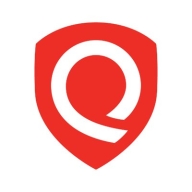

Qualys VMDR and Azure Kubernetes Service (AKS) compete in the IT management space, with Qualys focusing on vulnerability management and AKS on container orchestration. Based on user reviews, Qualys VMDR holds an advantage in scalability and reporting features, while AKS excels in integration with Azure services and ease of management.
Features: Qualys VMDR offers comprehensive vulnerability management, policy compliance, and cloud-based deployment. Its automated detection, asset management, and web application scanning are valuable features. AKS provides auto-scaling, integration with Azure Active Directory, and predefined security features. It is known for its Kubernetes orchestration and automation capabilities.
Room for Improvement: Qualys VMDR experiences false positives and complex reporting. It would benefit from enhanced integration and user interface modernization. AKS faces obstacles with high costs and initial setup complexity. Improvement in pricing transparency and logging mechanisms would be beneficial.
Ease of Deployment and Customer Service: Qualys VMDR is versatile across hybrid and on-premises environments but has mixed customer service reviews, from efficient assistance to delayed responses. AKS is mainly used in public and hybrid clouds, praised for consistent, high-quality support despite slower responses.
Pricing and ROI: Qualys VMDR's pricing is flexible yet costly for smaller enterprises, but it reduces cybersecurity risks, enhancing ROI. AKS uses a pay-as-you-go model, but high scalability costs are reported. Nevertheless, its elasticity provides significant ROI for operational scalability and infrastructure management.
We saw a return on investment through significant savings in time, money, and resources.
They are very fast to respond and begin analysis to resolve problems.
We usually get on calls with tech support, and they are very helpful.
When reaching out via email, they reply quickly.
The response time takes a while.
AKS offers excellent scalability due to its adaptation from Kubernetes.
Scalability depends on the license and the number of assets being monitored.
Qualys VMDR can handle scalability, although increasing the inventory can raise the licensing costs.
Qualys VMDR's scalability is good, and the customer support is good.
From my usage, I would rate its stability as eight to nine out of ten.
It's very stable, and the support is satisfactory.
Qualys VMDR is stable.
When purchasing support directly from RHEL, the price is significantly high.
The costs are rising rapidly, and we have not seen any cost reductions by moving to Azure.
One area where Qualys VMDR can be improved is the missing feature for deploying agents for over 1,000 assets, as we need to do it manually.
It does not automate patching unless the patch management module is purchased separately.
If AI features were integrated, it could enhance the capabilities significantly.
The solution is very expensive in my opinion.
Transitioning to Azure did not bring cost reductions; in fact, costs are rising rapidly.
The pricing for Azure Kubernetes Service seems to be around the average, which I would rate as a five out of ten.
I have a notion that Qualys might be more expensive than Rapid7.
I would rate the pricing between seven to eight out of ten.
Qualys offers better pricing and is feature-packed compared to other tools.
EKS is the best because there are many features to use for scaling and to control the environments.
The most valuable features of Azure Kubernetes Service are its integration with Kubernetes, offering similar features for a seamless experience.
Since pricing is not a major concern, we chose the best fit for our application, which was specifically designed for this particular platform.
The prioritization of vulnerabilities has improved our remediation efforts by around thirty to thirty-five percent.
It impacts my workflow overall, with the patch management features as it has the missing patches listed in detail, making it easier to get a comprehensive report and providing some dashboards that offer visual representation.
Qualys VMDR provides a real-time response and reporting feature, which is excellent.
| Product | Market Share (%) |
|---|---|
| Qualys VMDR | 2.4% |
| Azure Kubernetes Service (AKS) | 0.8% |
| Other | 96.8% |

| Company Size | Count |
|---|---|
| Small Business | 15 |
| Midsize Enterprise | 7 |
| Large Enterprise | 22 |
| Company Size | Count |
|---|---|
| Small Business | 20 |
| Midsize Enterprise | 12 |
| Large Enterprise | 69 |
Azure Kubernetes Service (AKS) is a fully managed container orchestration service provided by Microsoft Azure. It simplifies the deployment, management, and scaling of containerized applications using Kubernetes. With AKS, developers can focus on building applications while Azure takes care of the underlying infrastructure. It offers features like automatic scaling, monitoring, and security, ensuring high availability and reliability. AKS integrates seamlessly with other Azure services, enabling easy integration with existing workflows. It also provides a flexible and open-source environment, allowing developers to use their preferred tools and frameworks. With AKS, organizations can accelerate their application development and deployment processes, while reducing operational overheads.
Vulnerability Management, Detection, and Response (VMDR) is a cornerstone product of the Qualys TruRisk Platform and a global leader in the enterprise-grade vulnerability management (VM) vendor space. With VMDR, enterprises are empowered with visibility and insight into cyber risk exposure - making it easy to prioritize vulnerabilities, assets, or groups of assets based on business risk. Security teams can take action to mitigate risk, helping the business measure their actual risk exposure over time.
Qualys VMDR offers an all-inclusive risk-based vulnerability management solution to prioritize vulnerabilities and assets based on risk and business criticality. VMDR seamlessly integrates with configuration management databases (CMDB), Qualys Patch Management, Custom Assessment and Remediation (CAR), Qualys TotalCloud and other Qualys and non-Qualys solutions to facilitate vulnerability detection and remediation across the entire enterprise.
With VMDR, users are empowered with actionable risk insights that translate vulnerabilities and exploits into optimized remediation actions based on business impact. Qualys customers can now aggregate and orchestrate data from the Qualys Threat Library, 25+ threat intelligence feeds, and third-party security and IT solutions, empowering organizations to measure, communicate, and eliminate risk across on-premises, hybrid, and cloud environments.
We monitor all Container Security reviews to prevent fraudulent reviews and keep review quality high. We do not post reviews by company employees or direct competitors. We validate each review for authenticity via cross-reference with LinkedIn, and personal follow-up with the reviewer when necessary.